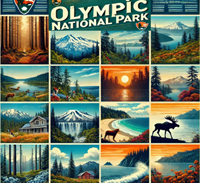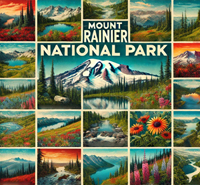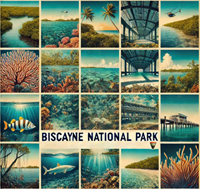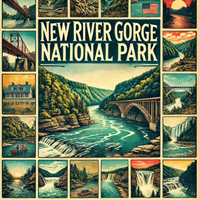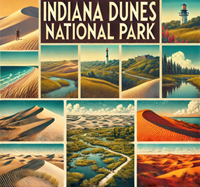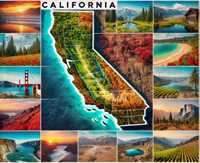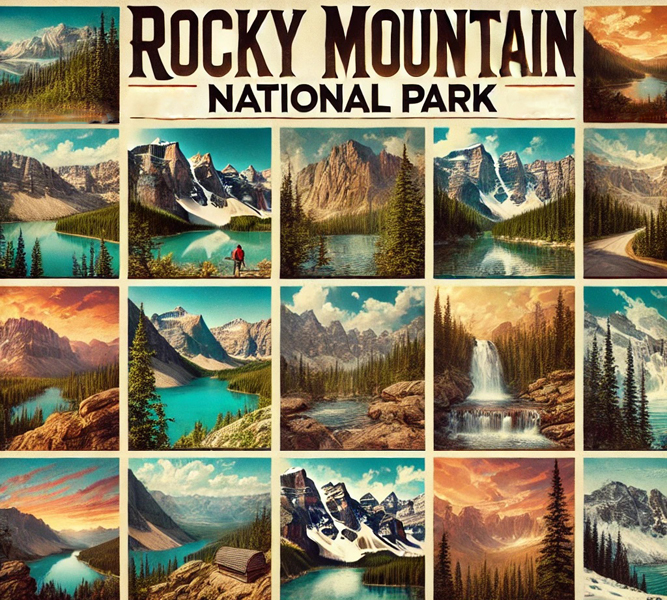

Embark on a journey curated by seasoned explorers William and Hui Cha Stanek, who have spent decades immersing themselves in the diverse landscapes of North America. These itineraries are more than just travel plans - they are thoughtfully crafted adventures designed to help you connect with the natural world, discover hidden gems, and create lasting memories.
National Parks Index | US Itineraries Index | American Roadtrips Index

Bring home a Bugville Critters book and watch as your child's love for reading and learning grows with every page. Hand-painted illustrations bring the heartwarming stories to life. Ask your librarian to add Bugville Critters to the library's digital collection today!
Discover William Stanek's Exclusive Art Collection
Explore and purchase the stunning art featured on this site. Own a piece of William Stanek's unique and captivating artwork today!
(May 2, 2025) Rocky Mountain National Park and Black Canyon of the Gunnison National Park: Colorado's Majestic Wilderness
Introduction: A 2-Day Journey Through the Wilderness
As the sun began to rise over the snow-capped peaks of Rocky Mountain National Park, Hui Cha and I found ourselves on the trail to Dream Lake, the air crisp and filled with the promise of a new day. It wasn't our first time in the park, but every visit brought with it a sense of renewal, a feeling that we were embarking on an entirely new adventure despite the familiar surroundings.
This particular morning, the early light painted the landscape in hues of pink and gold, casting long shadows that danced across the forest floor. As we hiked, the world seemed to come alive with the sounds of the wilderness – birds chirping, the rustle of leaves, and the distant trickle of a mountain stream. For me, this was the essence of Rocky Mountain National Park: a place where nature's beauty was on full display, where every step felt like a journey deeper into the heart of the wild.
But what made this day special wasn't just the stunning scenery or the quiet moments of reflection. It was the company – being with Hui Cha, sharing the experience, and feeling that unspoken connection that only comes when you're in the midst of something truly awe-inspiring. As we reached Dream Lake, the sight of the serene, reflective water surrounded by towering peaks took our breath away. We sat on a rock by the lake's edge, silently taking it all in, the bond between us as strong as the mountains themselves.
Later that afternoon, after exploring more of Rocky Mountain's rugged beauty, we decided to make the journey to Black Canyon of the Gunnison National Park. The drive itself was a lesson in contrasts – leaving behind the gentle curves and lush forests of the Rockies for the stark, dramatic landscapes of the Black Canyon. As we approached the canyon, the land opened up into a vast, unforgiving wilderness, the deep chasm cutting through the earth like a jagged scar.
Standing at the edge of the canyon at sunset, the sheer drop below was both terrifying and mesmerizing. The dark shadows of the canyon walls seemed to stretch endlessly downward, the river far below winding through the depths like a silver ribbon. It was a landscape that demanded respect, a place where nature's power was palpable in every rock and crevice.
In that moment, I realized how much these parks had to teach us – not just about the natural world, but about ourselves. In the face of such grandeur, our worries and concerns seemed trivial, our place in the world both small and significant. These parks were not just destinations; they were experiences that shaped us, challenged us, and brought us closer to the essence of life.
Join us as we take you on a journey through these two remarkable parks – Rocky Mountain National Park and Black Canyon of the Gunnison National Park. We'll share our stories, tips, and insights to help you create your own unforgettable experiences in Colorado's majestic wilderness.
Day 1: Discovering the Wonders of Rocky Mountain National Park
Morning: Sunrise at Bear Lake
Overview
The day begins early with a visit to Bear Lake, one of Rocky Mountain National Park's most iconic and accessible spots. Located at an elevation of 9,450 feet, Bear Lake is a short, easy walk from the parking area, making it the perfect place to start your day with a breathtaking sunrise.
Tips from William
"Arrive at the Bear Lake parking lot by 5:30 AM to ensure you get a spot – this area fills up quickly, especially during peak season. Bring a tripod and a wide-angle lens to capture the full spectrum of the sunrise as it lights up the surrounding peaks. A polarizing filter can help reduce reflections on the lake's surface, allowing you to capture the clarity of the water and the reflections of the mountains."
Insights from Hui Cha
"Dress warmly, even in summer, as the early morning temperatures at this elevation can be quite chilly. I always bring a thermos of hot coffee and some snacks to enjoy while waiting for the sun to rise. The quiet moments before dawn are perfect for reflection and taking in the serenity of the surroundings."
How to Access Bear Lake
Directions:
- From Estes Park, take US 36 west to the Beaver Meadows Entrance Station.
- Follow the signs for Bear Lake Road and continue for about 9 miles until you reach the Bear Lake parking area.
Trail Details:
- Trail Length: 0.6 miles round-trip (flat and accessible)
- Elevation Gain: Minimal
- Difficulty: Easy
Photography Tips: Set up your tripod on the eastern shore of Bear Lake to capture the mountains reflected in the water as the sun rises behind you. For a more creative shot, try framing the scene with the surrounding trees, using them to add depth and perspective to your image.
Mid-Morning: Exploring the Trail to Dream Lake
Overview
After witnessing the sunrise at Bear Lake, continue your exploration by hiking to Dream Lake. This popular trail offers stunning views of alpine lakes and the surrounding mountains, with Dream Lake being the crown jewel of the hike.
Tips from William
"The trail to Dream Lake is relatively short but does involve some elevation gain. Start early to avoid the crowds and bring plenty of water. I recommend a wide-angle lens for capturing the expansive views, but also keep a telephoto lens handy for wildlife that you might encounter along the way."
Insights from Hui Cha
"Take your time on this hike and enjoy the journey as much as the destination. The trail passes by Nymph Lake and Dream Lake, both of which offer beautiful spots to stop and take in the scenery. I always find a quiet spot by Dream Lake to sit and reflect – it's a place that feels almost sacred in its beauty."
How to Access Dream Lake
Directions:
- Start at the Bear Lake Trailhead (same as for Bear Lake).
- Follow the signs for Dream Lake, passing Nymph Lake along the way.
Trail Details:
- Trail Length: 2.2 miles round-trip
- Elevation Gain: 450 feet
- Difficulty: Moderate
Photography Tips: For the best shots of Dream Lake, position yourself near the water's edge to capture the reflections of the surrounding peaks. Use a polarizing filter to enhance the colors and reduce glare. If you're lucky enough to be there on a calm day, you can capture the mirror-like surface of the lake with the mountains perfectly reflected.
Alternative Activity: If the hike to Dream Lake is too challenging, consider hiking to Nymph Lake, which is only 1.1 miles round-trip with a gentle elevation gain of 225 feet. Nymph Lake is smaller but equally beautiful, with lily pads dotting the surface and a backdrop of towering peaks.
Afternoon: Driving the Trail Ridge Road
Overview
Trail Ridge Road is one of the most spectacular drives in North America, taking you above the treeline and offering panoramic views of the Rocky Mountains. This scenic drive reaches an elevation of over 12,000 feet and is a must-do activity in Rocky Mountain National Park.
Tips from William
"Plan to spend at least a few hours on Trail Ridge Road, as there are numerous overlooks and short trails to explore along the way. Bring a telephoto lens to capture wildlife such as elk, marmots, and bighorn sheep, which are often seen grazing near the road."
Insights from Hui Cha
"Take it slow on this drive and stop frequently to fully appreciate the views. The air can be thin at this elevation, so take your time and don't rush. I always bring a picnic lunch to enjoy at one of the overlooks – there's something truly special about dining with the mountains as your backdrop."
How to Access Trail Ridge Road
Directions:
- From Estes Park, take US 36 west to the Beaver Meadows Entrance Station.
- Continue on Trail Ridge Road (also known as US 34) through the park.
Route Details:
- Total Distance: 48 miles (one-way)
- Elevation Gain: 4,000+ feet
- Difficulty: Easy (driving)
Photography Tips: Stop at the Many Parks Curve overlook early in the drive for sweeping views of the park. As you ascend, the Forest Canyon Overlook offers an incredible vantage point to photograph the vast wilderness below. Use a wide-angle lens to capture the grandeur of the landscape, and switch to a telephoto lens to focus on wildlife and distant peaks.
Alternative Activity: If you prefer a shorter drive, consider exploring the Old Fall River Road, which is a one-way, 11-mile gravel road that offers a more intimate experience with the park's landscape. The road is narrow and winding, providing a different perspective of the mountains.
Evening: Sunset at Sprague Lake
Overview
End your day with a peaceful walk around Sprague Lake, a picturesque spot that offers stunning views of the sunset reflected in the water. This is a great place to relax and reflect on the day's adventures.
Tips from William
"Sprague Lake is one of the best places in the park to capture a sunset, especially if you're looking to photograph the warm glow of the sun on the peaks. Set up your tripod on the western shore of the lake to capture the reflections in the water."
Insights from Hui Cha
"Sprague Lake is also a great spot for birdwatching, so bring binoculars if you have them. The trail around the lake is flat and easy, making it accessible for everyone. I love to bring a blanket and just sit by the shore, enjoying the changing colors of the sky."
How to Access Sprague Lake
Directions:
- From the Beaver Meadows Entrance Station, take Bear Lake Road for approximately 6 miles.
- Turn right at the Sprague Lake sign and follow the road to the parking area.
Trail Details:
- Trail Length: 0.8 miles round-trip (loop)
- Elevation Gain: Minimal
- Difficulty: Easy
Photography Tips: For a perfect reflection shot, arrive at least 30 minutes before sunset to set up and find the best angle. Use a slow shutter speed to capture the movement of the water if there's a slight breeze. If the conditions are calm, a fast shutter speed will allow you to capture the sharp reflections of the surrounding peaks.
Alternative Activity: If you prefer a shorter evening activity, consider visiting Moraine Park for wildlife viewing. This open valley is a prime spot to see elk, especially during the evening hours. Bring a telephoto lens to capture close-up shots of the animals without disturbing them.
Reflections on the Day
As the sun dipped below the horizon, casting a golden glow over Sprague Lake, Hui Cha and I found ourselves reflecting on the day's adventures. From the tranquil beauty of Bear Lake at sunrise to the awe-inspiring views from Trail Ridge Road, and finally the serene sunset at Sprague Lake, each moment felt like a gift from the wilderness.
What made this day special wasn't just the stunning landscapes we encountered – it was the feeling of being completely immersed in nature, of disconnecting from the hustle and bustle of everyday life and reconnecting with what truly matters. These are the experiences that stay with you long after the trip is over, the memories that bring a smile to your face on a busy day, and the moments that remind you of the beauty that exists in the world.
As we packed up our gear and headed back to our cabin, I couldn't help but feel a deep sense of gratitude. Gratitude for the opportunity to explore these incredible places, for the time spent with Hui Cha, and for the realization that these parks are not just destinations – they are a part of who we are.
Join us tomorrow as we continue our journey to Black Canyon of the Gunnison National Park, where the landscape takes on a new, more dramatic form, and the adventures are just as unforgettable.
Day 2: The Rugged Beauty of Black Canyon of the Gunnison National Park
Morning: Sunrise at Gunnison Point
Overview
Begin your day at Black Canyon of the Gunnison National Park with a sunrise at Gunnison Point. Located near the South Rim Visitor Center, this overlook provides one of the most dramatic views of the canyon, with the early morning light casting long shadows and illuminating the sheer cliffs.
Tips from William
"Arrive at Gunnison Point by 5:30 AM to set up your tripod and find the perfect angle. Use a telephoto lens to capture the intricate details of the canyon walls, and don't forget a wide-angle lens to capture the vastness of the scene. A graduated neutral density filter can help balance the exposure between the bright sky and the darker canyon."
Insights from Hui Cha
"Even in summer, mornings at Black Canyon can be chilly, so dress in layers. I like to bring a small thermos of tea and enjoy a quiet moment at the overlook before the sun rises. The solitude and the sound of the wind through the canyon make it a truly meditative experience."
How to Access Gunnison Point
Directions:
- From Montrose, take US-50 East for approximately 8 miles to the turnoff for CO-347.
- Follow CO-347 for about 6 miles to the South Rim Entrance Station.
- Continue past the entrance station for 1.5 miles to the South Rim Visitor Center, where you'll find the trail to Gunnison Point.
Trail Details:
- Trail Length: 0.2 miles round-trip
- Elevation Gain: Minimal
- Difficulty: Easy
Photography Tips: Set up on the eastern side of the overlook to capture the first light hitting the canyon walls. Use a small aperture (f/16 or smaller) to keep the entire scene in focus. If you're interested in capturing the movement of the Gunnison River far below, a telephoto lens will allow you to zoom in and emphasize the river's serpentine path through the canyon.
Alternative Activity: If you prefer a more leisurely morning, consider starting your day with a scenic drive along the South Rim Road, stopping at various overlooks to capture the sunrise from different perspectives.
Mid-Morning: Exploring the South Rim Road
Overview
The South Rim Road offers a series of overlooks and short trails that provide breathtaking views of Black Canyon's dramatic landscape. This 7-mile road is a must-do activity, offering access to some of the most iconic viewpoints in the park.
Tips from William
"Plan to spend at least two to three hours exploring the South Rim Road. Each overlook offers a unique perspective of the canyon, so take your time and don't rush from one spot to the next. Bring a wide-angle lens to capture the full scope of the canyon, and a telephoto lens to zoom in on the details."
Insights from Hui Cha
"I love the variety of overlooks along the South Rim Road – each one offers a different view of the canyon, and it's fascinating to see how the light changes as you move from one spot to another. Bring a sketchbook or journal to capture your thoughts and impressions as you explore."
How to Access the South Rim Road
Directions:
- Start at the South Rim Visitor Center and follow the South Rim Road for 7 miles, stopping at the various overlooks along the way.
Overlook Highlights:
- Pulpit Rock Overlook: Offers a sweeping view of the canyon with the river visible far below.
- Chasm View Overlook: Provides a close-up view of the narrowest section of the canyon, where the walls are only 1,100 feet apart.
- Painted Wall Overlook: Features the tallest cliff in Colorado, with its striking vertical stripes of rock.
Photography Tips: At the Painted Wall Overlook, use a telephoto lens to focus on the intricate patterns of the rock face. For a wider shot, position yourself at the edge of the overlook and use a wide-angle lens to capture the Painted Wall in its entirety, along with the surrounding landscape. Experiment with different exposures to capture the contrast between the sunlit cliffs and the shaded depths of the canyon.
Alternative Activity: If you prefer a shorter exploration, consider focusing on the Chasm View Nature Trail, a 0.5-mile loop that offers spectacular views of the canyon's narrowest point. The trail is easy and suitable for all ages, making it a great alternative to the longer drive.
Afternoon: Hiking the Warner Point Nature Trail
Overview
For those seeking a moderate hike with rewarding views, the Warner Point Nature Trail is an excellent choice. This trail offers panoramic views of the canyon, the surrounding mountains, and the Gunnison River far below.
Tips from William
"The Warner Point Nature Trail is a 1.5-mile round-trip hike with some elevation gain, so be prepared for a bit of a workout. Bring a polarizing filter to enhance the colors and reduce glare, especially when photographing the river. The trail offers multiple viewpoints, so take your time and explore each one."
Insights from Hui Cha
"Warner Point is one of my favorite spots in the park because of the sweeping views it offers. The trail is relatively short, but it feels like a true wilderness experience. Bring a light snack and plenty of water – you'll want to spend some time at the viewpoints, taking in the scenery."
How to Access Warner Point Nature Trail
Directions:
- The trailhead is located at the end of the South Rim Road, near the High Point Overlook.
Trail Details:
- Trail Length: 1.5 miles round-trip
- Elevation Gain: 250 feet
- Difficulty: Moderate
Photography Tips: For the best shots, start your hike in the late afternoon when the light is softer. Use a telephoto lens to zoom in on the details of the canyon walls and the river below. The viewpoints along the trail offer opportunities for both wide-angle landscape shots and more focused compositions.
Alternative Activity: If you're looking for a less strenuous activity, consider hiking the Oak Flat Loop Trail, a 2-mile loop with moderate elevation gain that offers a close-up view of the canyon's rim. The trail is relatively easy, with several spots to stop and take in the views.
Evening: Sunset at Sunset View Overlook
Overview
End your day with a visit to the aptly named Sunset View Overlook, where you can watch the sun dip below the horizon, casting a warm glow over the canyon. This is one of the best spots in the park to witness the sunset, offering a peaceful and serene atmosphere.
Tips from William
"Arrive at least 30 minutes before sunset to find a good spot and set up your camera. A graduated neutral density filter will help balance the exposure between the bright sky and the darker canyon. Don't forget to capture the afterglow, when the sky turns pink and purple – it's one of the most magical times to photograph the canyon."
Insights from Hui Cha
"I love ending the day at Sunset View Overlook. The colors of the canyon are so vibrant in the fading light, and there's a sense of calm and reflection that comes with watching the sunset here. Bring a blanket and a warm drink – it can get chilly as the sun goes down."
How to Access Sunset View Overlook
Directions:
- From the South Rim Visitor Center, follow the South Rim Road for 6 miles to the Sunset View parking area.
Photography Tips: Use a tripod to keep your camera steady as the light fades. Experiment with long exposures to capture the movement of the clouds and the changing colors of the sky. For a more dramatic shot, include the canyon's edge in the foreground, leading the viewer's eye into the scene.
Alternative Activity: If you prefer a quieter spot for sunset, consider visiting the Dragon Point Overlook. This overlook is less crowded and offers equally stunning views of the canyon at sunset. The hike to the overlook is short and easy, making it a great alternative to the more popular spots.
A Personal Reflection
As the last rays of sunlight faded from the canyon, Hui Cha and I sat quietly at the overlook, reflecting on the incredible journey we had just experienced. From the serene beauty of Rocky Mountain National Park to the rugged, awe-inspiring landscapes of Black Canyon of the Gunnison, each moment had been a reminder of the power and majesty of nature.
These parks are more than just places to visit – they are places to connect with the natural world, to find peace and inspiration, and to create memories that will last a lifetime. As we packed up our gear and prepared to leave, I felt a deep sense of gratitude for the time we had spent in these wild, untamed places. They had not only shown us the beauty of the land but had also brought us closer to each other and to the world around us.
Our journey through Colorado's majestic wilderness had come to an end, but the experiences we had shared would stay with us forever. And as we drove away from the canyon, I knew that we would return, drawn back by the promise of new adventures and the chance to explore even deeper into the heart of the wild.

Step into a world of timeless beauty with our premium, oversized hardcover book - crafted for discerning collectors and anyone who values the power of art. Perfect for your coffee table, it's more than just a book; it's a conversation starter, a window into over 30 years of William's visionary photography.
Your Support Matters
Purchasing artwork from William Stanek's collection not only brings beauty into your life but also helps us continue to share. Thank you for supporting our creative journey!

Support The Lights of Paris by Robert Stanek, William Stanek's pen name! Through vivid historical detail and deeply moving character stories, Robert takes readers on an unforgettable journey through one of history’s most transformative times.


